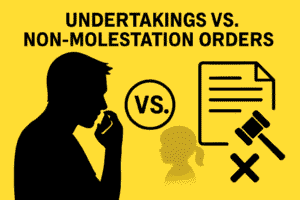“Last Updated” Date: Thursday, 9 October 2025
Living under the weight of a non-molestation order can feel relentless. It’s a situation where you might feel you have been subjected to significant emotional discomfort, navigating a world of restrictions that impact your life and your relationship with your children, even when you feel you’ve done nothing wrong. The constant fear of an accidental breach is exhausting.
The good news is that these orders are not a life sentence. If your circumstances have changed, there is a clear legal path to either vary (change) or completely discharge (remove) the order. The stakes are high, but this guide provides a clear, strategic roadmap. It explains the process, the evidence you need, and the common mistakes to avoid, giving you the best chance of success in court.
Key Takeaways
- You Can Apply at Any Time: You do not have to wait for an order to expire. You can apply to the court to change or end it using a specific court form, the FL403.
- Prove a “Material Change”: This is the single most critical test. To succeed, you must provide the judge with solid evidence that something significant has changed since the original order was made.
- Vary vs. Discharge: “Varying” an order changes some of its terms while keeping it in place. “Discharging” it ends the order and all its restrictions completely.
- Your Conduct is Your Best Evidence: The most powerful evidence you can have is a long, unbroken period of perfect compliance with the order, which demonstrates you are not a risk.
Want one-to-one guidance on this? Message us now on WhatsApp.
Jump To
- A Deep Dive: Material Change in Circumstances
- Your Practical Checklist: Key Steps for Your Application
- At a Glance: Varying an Order vs. Discharging an Order
- Common Mistakes When Applying to Discharge an Order
- FAQs about Varying & Discharging an Order
From my time as a Cafcass and Children’s Services social worker, I’ve seen countless cases hinge on this one principle: evidence. You cannot simply tell a judge things have changed; you must present a compelling, evidence-based argument that the order is no longer necessary, and this guide will show you how.
A Deep Dive: A Material Change in Circumstances
Official Definition: A “material change in circumstances,” as considered under UK Family Law, is a significant, factual change that has occurred since the original order was made, which is substantial enough to justify the court reconsidering its original decision. It must be a change that fundamentally alters the balance of risk the first judge considered.
Completion of Courses or Therapy
If the original order was made due to specific concerns like anger management or substance misuse, proving you have proactively addressed these issues is a powerful demonstration of change.
What This Means For You: Providing a certificate showing you have successfully completed a recognised course is tangible evidence that you have taken the court’s concerns seriously and have worked to mitigate any perceived risk.
A Long Period of Compliance and Stability
Demonstrating that you have followed the order perfectly for a significant period (e.g., 9-12 months) and that there have been no incidents of any kind is a compelling argument that the order has served its purpose.
What This Means For You: Your behaviour is your best evidence. A clean record shows the judge that you are not the risk you were perceived to be and that the restrictions are now disproportionate.
Successful, Problem-Free Child Contact
If child arrangements have been taking place without any issues, this can be used as evidence that the original fears that led to the order have not materialised and you are not a risk to your child.
What This Means For You: Positive, uneventful child contact, especially if it has progressed from supervised to unsupervised, is a clear indicator of a stable and safe situation, which directly counters the need for a restrictive order.
Example: Snippet from a Witness Statement to Discharge an Order
The original order was made on 10th October 2024. I have complied with all terms of the order for the past 11 months without issue. There have been no breaches, and the police have not been called.
The primary basis for the order was the Applicant’s concern about my alcohol use. I have since completed a six-month alcohol awareness course. A certificate of completion is attached at Exhibit A.
Furthermore, unsupervised contact with our child has been progressing successfully for the last four months, as confirmed in the Applicant’s own text messages at Exhibit B.
I believe these points demonstrate a material change in circumstances. The risk the order was designed to prevent has been addressed, and the order is therefore no longer necessary or proportionate.
A Real Life Scenario: An order was made against Ben following a single, heated argument where he damaged a door. For the next 10 months, he complies perfectly. Child contact, which started at a contact centre, is now unsupervised and going well. The constant stress of the order is affecting him. Ben applies to discharge the order, pointing to his 10 months of compliance and the positive, problem-free contact as his evidence of a material change. The judge agrees the order has served its purpose and is no longer necessary, and duly discharges it.
Your Practical Checklist: Key Steps for Your Application
A successful application is a well-prepared one. Follow these steps methodically to build the strongest possible case for the court.
- Obtain the Correct Form: You must use Form FL403 to make your application. You can download Form FL403 from the official gov.uk website. Ensure you are using the most up-to-date version.
- Draft a Persuasive Witness Statement: This is the core of your application. Your statement must clearly and calmly set out the “material change in circumstances.” List the facts, refer to your evidence, and explain why the order is no longer necessary or proportionate.
- Compile Your Evidence: You cannot just make claims; you must back them up. Gather any certificates of course completion, letters from professionals, or records of communication (e.g., text messages showing successful co-parenting) that support your case.
- Submit Your Application: File the completed FL403 form and your witness statement with the family court that made the original order. You will also need to pay the court fee unless you are eligible for an exemption.
At a Glance: Varying an Order vs. Discharging an Order
It’s crucial to choose the right application for your specific situation. This table breaks down the key differences.
| Feature | Applying to Vary | Applying to Discharge |
|---|---|---|
| Goal | ✅ To change a specific term of the order that is impractical or unnecessary. | ❌ To end the entire order and all of its restrictions completely. |
| When to Use It | When one part of the order is causing problems, but you accept some restrictions are still needed (e.g., changing a handover location). | When you believe the order as a whole is no longer necessary because the original risks have gone away. |
| Example | “The order stops me from attending my child’s school. I wish to vary it to allow me to attend school sports days only.” | “I have completed an anger management course and there have been no issues for 12 months. The order is no longer needed.” |
| Legal Test | Show a change in circumstances that makes the specific term unfair or unnecessary. | Show a significant, material change in circumstances that makes the entire order redundant. |
| Outcome | ✅ The order remains in place, but with amended terms. | ❌ The order is cancelled and you are no longer bound by its terms. |
Avoid costly mistakes — chat with us today and get practical, fixed-fee support.
Common Mistakes When Applying to Discharge an Order
When I was writing reports for the court, the biggest mistake I saw dads make was reacting emotionally instead of strategically. It’s easy to make a small error in a moment of frustration that can have a huge negative impact on your case. Avoiding these common pitfalls is essential.
Common Pitfalls:
- Thinking “Time Served” is Enough: Why this is a mistake: Simply waiting a few months is not a “change in circumstances.” A judge needs to see that something has actively changed, either in your behaviour or the situation, not just that time has passed.
- Applying Too Soon: Why this is a mistake: Applying after only a couple of months is highly unlikely to succeed. A judge will want to see a sustained period of change and stability before they will consider removing an order.
- Breaching the Order While Applying: Why this is a mistake: This is the worst possible error. It proves to the judge that the order is still very much necessary and will almost certainly lead to your application being dismissed and could lead to your arrest. If you feel the order is based on lies, you must know how to properly defend against a false non-molestation order, not breach it.
FAQs about Varying & Discharging an Order
Fathers looking to end an order often ask these common questions. Here are clear, straightforward answers.
What is the difference between “varying” and “discharging” an order?
“Varying” means you are asking the court to change one or more of the specific terms of the order, but the order itself remains in place. “Discharging” means you are asking the court to cancel or erase the order completely.
What are valid reasons to discharge a non-molestation order?
The most common reason is a “material change in circumstances.” This could include a long period of compliance with the order, successful completion of relevant courses (like anger management), proof that child contact is now working well without any issues, or reconciliation between you and your ex-partner. You can read more in our full non-molestation order guide.
How do I apply to the court to vary or discharge an order?
You must make a formal application to the court using the Form FL403. You must attach a written witness statement to the form explaining your reasons and providing your evidence.
Can I agree with my ex-partner to end the order early?
Yes, you can agree. This is called a “discharge by consent.” You would still need to submit an application to the court with a signed consent order, and a judge would have to approve it, but it is a much quicker and simpler process. Sometimes a court will accept an agreement in the form of an undertaking as an alternative.
What evidence do I need to support my application?
You need evidence that proves the “change in circumstances.” This could be a certificate of course completion, a letter from a professional, or your own witness statement detailing a long period of compliance and successful co-parenting.
Does a non-molestation order expire automatically?
Yes. A non-molestation order is always made for a specific period of time (e.g., 12 months). It will automatically expire on the date stated on the order unless your ex-partner applies to the court to extend it.
Get Expert Help to Remove Your Order
At Dads Consultancy, we provide the specialised, expert support to move you from crisis to control. We don’t just offer advice; we provide practical, hands-on assistance with the critical documents and stages of the family court process. We can help you with:
- Making Your Application (C100)
- Handling the CAFCASS Call
- Navigating Child Arrangements Orders
- McKenzie Friend Support
- MIAM/Mediation Guidance
- Responding to Non-Molestation Orders
- Drafting Powerful Position Statements
- Navigating Section 7 Reports
An old non-molestation order shouldn’t define your future. With the right evidence and a strong application, you can move forward. WhatsApp us today for a strategic consultation, and let’s build a clear plan to get it removed.
🧠 Insider Insight: Lach, our founder, is a former Cafcass and Children’s Services Social Worker. He has been on the inside of the family court system, writing the very reports that influence court outcomes. Now he uses that insider knowledge to help dads navigate the process effectively. Learn more about Lach’s background.




